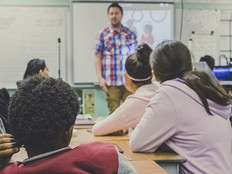Connections like these are exactly why Keller is a huge fan and user of TikTok and other social media platforms, which help educators find ideas — and each other. Keller says teachers are using the platform to grow a rich and supportive teacher network; there are over 100 million TikTok users in the U.S. They also discover tips and tricks for organizing classrooms and managing student behavior.
“One thing I love about TikTok is that teachers have a space to share what is working for them. As educators, we can share that great organizing tool or behavior management idea and give other teachers an opportunity to try something new or different,” says Keller.
However, when it comes to using TikTok in the classroom, Keller doesn’t recommend it. The algorithm is quite different than other social media platforms, like Twitter or Instagram. “A video can go viral, and content easily gets taken out of context,” she says. “I do like the video editing options that TikTok has and would recommend Capcut for teachers and students to use in lieu of TikTok.”
States Are Increasingly Banning TikTok Due to Security Concerns
Keller’s advice to not rely on TikTok in the classroom is not unusual. Restrictions on the app, which is owned by China-based ByteDance, are expanding across the U.S.
“Here in the state of Texas, we have been advised to remove TikTok from our district devices due to security concerns,” says Gary Lackey, director of cybersecurity at Goose Creek Consolidated Independent School District in Baytown, Texas.
RELATED: Goose Creek CISD receives CoSN's Trusted Learning Environment Seal.
Although the ban only covers state-owned devices, Lackey points out that “there are some major questions as to why you would want TikTok on a personal device, based on what we know about TikTok, but the state is not going to dictate what we should do personally.”
Texas isn’t alone in raising an eyebrow at the trendy video-sharing app: At least 30 other states have banned TikTok from state-owned devices, including those in schools, universities and government offices. The bans cite security, privacy and safety concerns. The U.S. federal government also implemented a ban on the use of TikTok on any federal government devices as of December 2022.
Educators Can Approach TikTok in the Classroom with an IT Mindset
Even with these limitations, educators can still legally use the platform on their personal devices. To stay safe, Keller — who uses her personal device to access her TikTok account — says that educators should follow their school district’s rules and regulations for the use of online platforms.
“I work hard to use it before or after my contract time,” she says. “As with anything, it is important to realize what you are putting out there. I often present on TikTok and other social media apps and remind people that just because something says it is private does not mean it is private.” For this reason, Keller sticks to professional content and creates videos that allow her to share what she is doing and to advocate for the library.
Regardless of the social media platform, there will always be security risks. A spokesperson for the Department of Education’s Student Privacy Policy Office refers educators to the agency’s Security Best Practices page, which includes helpful resources about protecting student data privacy and a checklist on what to look out for when working with apps.
Keller reminds students that TikTok is like many other social media platforms, where more interaction with certain content means they’ll be shown similar videos. She stresses to them the importance of looking at “different places for sources of information and also realizing that there is persuasion and bias.”
“I love being on TikTok, but I also understand how it works,” she adds.
KEEP READING: Teach K–12 students digital citizenship skills with ed tech.










